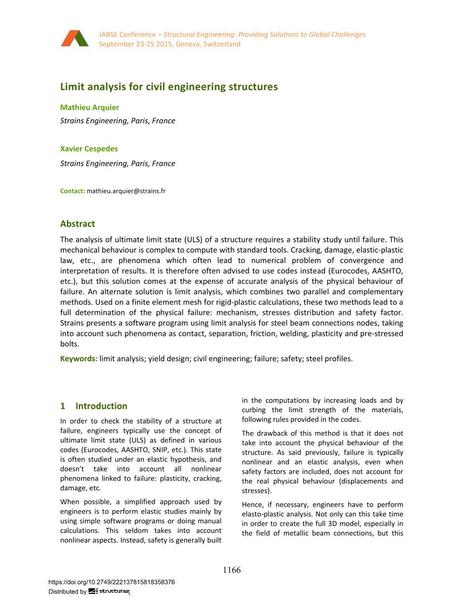Limit analysis for civil engineering structures

|
|
|||||||||||
Bibliographic Details
| Author(s): |
Mathieu Arquier
(Strains Engineering, Paris, France)
Xavier Cespedes (Strains Engineering, Paris, France) |
||||
|---|---|---|---|---|---|
| Medium: | conference paper | ||||
| Language(s): | English | ||||
| Conference: | IABSE Conference: Structural Engineering: Providing Solutions to Global Challenges, Geneva, Switzerland, September 2015 | ||||
| Published in: | IABSE Conference Geneva 2015 | ||||
|
|||||
| Page(s): | 1166-1178 | ||||
| Total no. of pages: | 13 | ||||
| Year: | 2015 | ||||
| DOI: | 10.2749/222137815818358376 | ||||
| Abstract: |
The analysis of ultimate limit state (ULS) of a structure requires a stability study until failure. This mechanical behaviour is complex to compute with standard tools. Cracking, damage, elastic-plastic law, etc., are phenomena which often lead to numerical problem of convergence and interpretation of results. It is therefore often advised to use codes instead (Eurocodes, AASHTO, etc.), but this solution comes at the expense of accurate analysis of the physical behaviour of failure. An alternate solution is limit analysis, which combines two parallel and complementary methods. Used on a finite element mesh for rigid-plastic calculations, these two methods lead to a full determination of the physical failure: mechanism, stresses distribution and safety factor. Strains presents a software program using limit analysis for steel beam connections nodes, taking into account such phenomena as contact, separation, friction, welding, plasticity and pre-stressed bolts. |
||||
| Keywords: |
failure safety limit analysis civil engineering yield design steel profiles
|
||||
